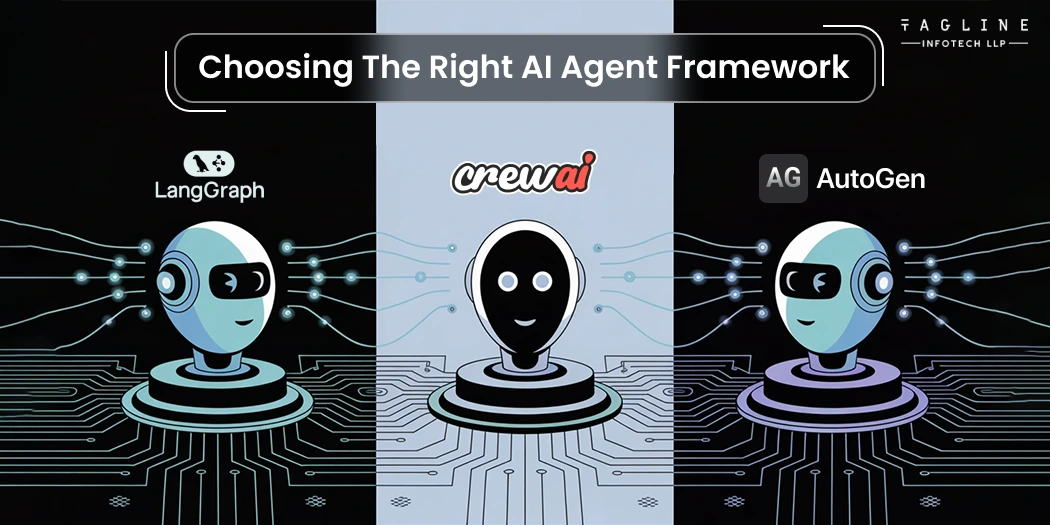Role of Python Libraries in Image Processing
October 30, 2025
Home >> AI Agent >> Choosing the Right AI Agent Framework: LangGraph vs. CrewAI vs. AutoGen

AI agents are transforming workflows across industries—from automating research and analytics to powering customer service bots and complex decision-making systems. But with the rapid rise of agentic frameworks, choosing the right platform can be daunting. Whether you’re a business leader or a lovable developer for hire looking to implement AI solutions, understanding which framework to use is critical. Should you leverage LangGraph’s structured LLM workflows, CrewAI’s role-based multi-agent orchestration, or AutoGen’s advanced coordination for large-scale AI systems?
Each framework comes with its own strengths, trade-offs, and ideal use cases. Making the wrong choice can lead to wasted time, frustrated teams, and missed opportunities for innovation.
In this blog, we provide a detailed comparison of LangGraph, CrewAI, and AutoGen, including practical use cases, side-by-side feature breakdowns, and guidance to help you make an informed decision. By the end, you’ll have the insights you need to select the framework best suited for your business or technical needs.
LangGraph focuses on automation and workflow orchestration. Its visual graph-based interface allows developers and non-technical teams to design complex multi-agent workflows with minimal coding. If you’re looking to implement these solutions quickly, hiring a workflow developer can help streamline your projects and ensure efficient deployment.
Strengths:
Ideal Use Cases:
Potential Drawbacks:
CrewAI emphasizes collaboration between multiple AI agents and is optimized for team productivity and real-time decision-making.
Strengths:
Ideal Use Cases:
Potential Drawbacks:
AutoGen is built for advanced AI applications, including research workflows, generative AI pipelines, and AI-powered decision systems.
Strengths:
Ideal Use Cases:
Potential Drawbacks:
When selecting the right AI agent framework, nothing is more useful than a direct, side-by-side comparison. Each platform—LangGraph, CrewAI, and AutoGen—approaches multi-agent systems differently, offering unique capabilities for workflow automation, collaboration, and advanced AI applications.
The table below highlights their core strengths, limitations, and best-fit scenarios, giving you a clear view of which framework aligns with your technical requirements and business goals:
| Feature / Framework | LangGraph | CrewAI | AutoGen |
|---|---|---|---|
| Primary Focus | Workflow Automation | Multi-Agent Collaboration | Advanced AI Applications |
| Ease of Use | High | Medium | Medium-Low |
| Scalability | Medium | High | High |
| Integration | LangChain-native | Medium | High |
| Best for | SMEs, rapid deployment | Teams, research workflows | Enterprises, developers |
| Community Support | Active | Lightweight modular | Tool API-friendly |
This comparison makes it easier to see where each framework excels and where it may fall short. Whether you prioritize ease of adoption, scalability, or advanced flexibility, the right choice depends on your specific use case.
Follow this simple checklist:
Scenario Examples:
Each AI agent framework—LangGraph, CrewAI, and AutoGen—excels in different real-world applications. The key to making the right choice is matching your project needs with the framework’s strengths. Here’s how they compare across common scenarios:
CrewAI is ideal for step-by-step, predictable processes where tasks can be divided clearly between agents. It works best for:
Its role-driven design makes CrewAI a strong fit for businesses seeking straightforward automation without unnecessary complexity.
LangGraph shines in workflows that require conditional branching and logic-based routing. With its graph-based design, it’s well-suited for:
LangGraph’s stateful execution ensures that workflows adapt dynamically, making it the go-to choice for projects that demand flexibility and structured logic.
AutoGen stands out when your workflow requires interactive collaboration between humans and AI agents. Its conversational strengths make it perfect for:
If your system depends on real-time back-and-forth exchanges, AutoGen delivers the flexibility to keep humans engaged in the loop.
At Tagline Infotech, we specialize in building robust, scalable solutions powered by leading AI agent frameworks like LangGraph, CrewAI, and AutoGen. Our expertise lies in helping businesses harness these tools to design intelligent, workflow-driven systems that improve automation, decision-making, and customer engagement.
Our team of experienced developers and AI specialists ensures every solution is tailored to your unique requirements—whether you need:
From rapid prototyping to enterprise-scale deployment, we provide end-to-end support, including ongoing optimization and maintenance. Our approach ensures your AI systems remain reliable, efficient, and future-ready.
By partnering with Tagline Infotech, you gain more than technical expertise—you gain a trusted team dedicated to delivering cutting-edge AI solutions that align seamlessly with your business goals. Whether you’re building AI-powered assistants, automation pipelines, or data-driven decision platforms, we bring the tools, innovation, and proven experience to turn your vision into reality.
Choosing the right AI agent framework is not a one-size-fits-all decision—it depends on your use case, team capabilities, and long-term scalability goals.
CrewAI works best for structured, role-based workflows where tasks are predictable and easy to delegate.
AutoGen shines in human-in-the-loop systems and interactive applications where collaboration between people and AI agents is essential.
LangGraph is the strongest choice for complex logic and graph-based workflows, offering flexibility for projects that require conditional branching and adaptive decision-making.
Each framework has distinct advantages, and the smartest way forward is to prototype with your top choice before committing to full deployment. This helps validate performance, integration, and scalability in the context of your specific needs.
By carefully matching your goals with the right platform, you’ll set your team up for success and ensure your AI agents deliver measurable value.
CrewAI is best for structured, role-driven workflows like reports, scheduling, and routine automation.
Use LangGraph for logic-heavy pipelines, conditional branching, and complex decision-making systems.
AutoGen is ideal for human-in-the-loop workflows, enabling interactive coding, research, and collaboration.
Define goals, test prototypes, and evaluate ease of use, scalability, and integration before committing.
Created with Solvase

Digital Valley, 423, Apple Square, beside Lajamni Chowk, Mota Varachha, Surat, Gujarat 394101
D-401, titanium city center, 100 feet anand nagar road, Ahmedabad-380015
+91 9913 808 2851133 Sampley Ln Leander, Texas, 78641
52 Godalming Avenue, wallington, London - SM6 8NW